Numerical Analysis of the Relationship between Friction Coefficient and Repose Angle of Blast Furnace Raw Materials by Discrete Element Method
Abstract
:1. Introduction
2. Methodology
2.1. Experimental Method
2.1.1. EDEM
2.1.2. Measurement Method
2.2. Physical Experiment
2.3. Simulation
3. Experimental Results and Discussion
3.1. Simulation Results
3.1.1. Selection Appropriate Lifting Funnel Speed
3.1.2. Repose Angle of Different Blast Furnace Raw Materials
3.1.3. Relationship between CORF and Repose Angle
3.1.4. Relationship between COSF and Repose Angle
3.2. Comparison between Simulation and Physical Experiment
4. Summary
- (1)
- The repose angle increases with CORF and COSF, but the growth rate gradually decays or eventually even becomes negative for CORF ≥ 0.4 or COSF ≥ 0.35.
- (2)
- COSF has generally a greater effect than CORF on the repose angle.
- (3)
- The rougher the base surface, the larger is the repose angle of the particle pile formed, as a rough base surface reduces the displacement of the particles through the same path, thereby forming a higher particle pile.
- (4)
- The outlined procedure of fitting the contours of DEM-simulated piles with the experimental counterparts illustrate that appropriate CORF and COSF can be determined, which can be used to simulate the complex behavior of the burden in the ironmaking process.
Author Contributions
Funding
Institutional Review Board Statement
Informed Consent Statement
Data Availability Statement
Conflicts of Interest
References
- Stefania, S.; Zugliani., D.; Rosatti., G. A mathematical framework for modelling rock–ice avalanches. J. Fluid Mech. 2021, 919, 1–53. [Google Scholar]
- Janssen, H.A. Tests on grain pressure silos. Z. Vereins Deutsch. Ing. 1895, 39, 1045–1049. [Google Scholar]
- Hu, L.; Chen, Z.M.; Qian, C.L.; Zhou, L.W. Viscoelasticity of compressed granular assembly. Int. J. Mod. Phys. B 2003, 17, 217–220. [Google Scholar] [CrossRef]
- Jin, Y.; Lu, H.; Guo, X.; Gong, X. The effect of water addition on the surface energy, bulk and flow properties of lignite. Fuel Process. Technol. 2018, 176, 91–100. [Google Scholar] [CrossRef]
- Wei, X.; Bi, X.; Yong, Z. A model study of coke layer collapse in charging process in blast furnace. J. Wuhan Univ. Sci. Technol. 2007, 30, 342–345. [Google Scholar]
- Zaalouk, A.K.; Zabady, F.I. Effect of moisture content on angle of repose and friction coefficient of wheat grain. Misr J. Agric. Eng. 2009, 26, 418–427. [Google Scholar] [CrossRef]
- Zenit, R. Computer simulations of the collapse of a granular column. Phys. Fluids 2005, 17, 1–4. [Google Scholar] [CrossRef]
- Coetzee, C.J. Calibration of the discrete element method and the effect of particle shape. Powder Technol. 2016, 297, 50–70. [Google Scholar] [CrossRef]
- Ferreira, I.S.B.; Peruchi, R.S.; Fernandes, N.J.; Junior, P.R. Measurement system analysis in angle of repose of fertilizers with distinct granulometries. Measurement 2021, 170, 108681. [Google Scholar] [CrossRef]
- Santos, D.A.; Barrozo, M.A.S.; Duarte, C.R.; Weigler, F.; Mellmann, J. Investigation of particle dynamics in a rotary drum by means of experiments and numerical simulations using DEM. Adv. Powder Technol. 2016, 27, 692–703. [Google Scholar] [CrossRef]
- Miura, K.; Maeda, K.; Toki, S. Method of Measurement for the Angle of Repose of Sands. Soils Found. 1997, 37, 89–96. [Google Scholar] [CrossRef] [Green Version]
- Matuttis, H.G.; Luding, S.; Herrmann, H.J. Discrete element simulations of dense packings and heaps made of spherical and non-spherical particles. Powder Technol. 2000, 109, 278–292. [Google Scholar] [CrossRef]
- Wei, H.; Zan, L.; Li, Y.; Wang, Z.; Saxén, H.; Yu, Y. Numerical and experimental studies of corn particle properties on the forming of pile. Powder Technol. 2017, 321, 533–543. [Google Scholar] [CrossRef]
- Wei, H.; Tang, X.; Ge, Y.; Li, M.; Saxén, H.; Yu, Y. Numerical and experimental studies of the effect of iron ore particle shape on repose angle and porosity of a heap. Powder Technol. 2019, 353, 526–534. [Google Scholar] [CrossRef]
- Kon, T.; Natsui, S.; Ueda, S.; Inoue, R.; Ariyama, T. Development of blast Furnace Simulator Based on Particle Method. In Proceedings of the Asia Steel International Conference, Beijing China, 23–27 September 2012. [Google Scholar]
- Lajeunesse, E.; Mangeney-Castelnau, A.; Vilotte, J.P. Spreading of a granular mass on a horizontal plane. Phys. Fluids 2004, 16, 2371–2381. [Google Scholar] [CrossRef]
- Lube, G.; Huppert, H.E.; Sparks, R.S.J.; Hallworth, M.A. Axisymmetric collapses of granular columns. J. Fluid Mech. 2004, 508, 175–199. [Google Scholar] [CrossRef] [Green Version]
- Kejing, H.; Shoubin, D.; Zhaoyao, Z. Multigrid contact detection method. Phys. Rev. E Stat. Nonlinear Soft Matter Phys. 2007, 75, 036710. [Google Scholar]
- Staron, L.; Hinch, E.J. Study of the collapse of granular columns using DEM numerical simulation. J. Fluid Mech. 2005, 545, 1–27. [Google Scholar] [CrossRef] [Green Version]
- Staron, L.; Hinch, E.J. The spreading of a granular mass: Role of grain properties and initial conditions. Granul. Matter 2007, 9, 205–217. [Google Scholar] [CrossRef]
- Crosta, G.B.; Imposimato, S.; Roddeman, D. Numerical modeling of 2-D granular step collapse on erodible and nonerodible surface. J. Geophys. Res. Earth Surf. 2009, 114, 1–19. [Google Scholar] [CrossRef]
- Brilliantov, N.V.; Spahn, F.; Hertzsch, J.M.; PoSchel, T. Model for collisions in granular gases. Phys. Rev. E Stat. Phys. Plasmas Fluids Relat. Interdiscip. Top. 2002, 53, 5382–5392. [Google Scholar] [CrossRef] [Green Version]
- Zhou, Y.C.; Wright, B.D.; Yang, R.Y.; Xu, B.H.; Yu, A.B. Rolling friction in the dynamic simulation of sandpile formation. Phys. A Stat. Mech. Its Appl. 1999, 269, 536–553. [Google Scholar] [CrossRef]
- Ai, J.; Chen, J.-F.; Rotter, J.M.; Ooi, J.Y. Assessment of rolling resistance models in discrete element simulations. Powder Technol. 2010, 206, 269–282. [Google Scholar] [CrossRef]
- Deng, X.L.; Davé, R. Dynamic simulation of particle packing influenced by size, aspect ratio and surface energy. Granul. Matter 2013, 15, 401–415. [Google Scholar] [CrossRef]
- Boac, J.M.; Casada, M.E.; Maghirang, R.G.; Iii, J. Material and Interaction Properties of Selected Grains and Oilseeds for Modeling Discrete Particles. Trans. Asabe 2010, 53, 1201–1216. [Google Scholar] [CrossRef] [Green Version]
- Wei, H.; Nie, H.; Li, Y.; Saxén, H.; He, Z.; Yu, Y. Measurement and simulation validation of DEM parameters of pellet, sinter and coke particles. Powder Technol. 2020, 364, 593–603. [Google Scholar] [CrossRef]
- Charithkumar, K.; Goswami, T.K. Determination of properties of black pepper to use in discrete element modeling. J. Food Eng. 2019, 246, 111–118. [Google Scholar]
- Roessler, T.; Katterfeld, A. DEM parameter calibration of cohesive bulk materials using a simple angle of repose test. Particuology 2019, 45, 105–115. [Google Scholar] [CrossRef]
- Liu, F.; Zhang, J.; Li, B.; Chen, J. Calibration of parameters of wheat required in discrete element method simulation based on repose angle of particle heap. Trans. Chin. Soc. Agric. Eng. 2016, 32, 247–253. [Google Scholar]
- Wensrich, C.M.; Katterfeld, A. Rolling friction as a technique for modelling particle shape in DEM. Powder Technol. 2012, 217, 409–417. [Google Scholar] [CrossRef]
- Pasha, M.; Hare, C.; Ghadiri, M.; Gunadi, A.; Piccione, P.M. Effect of particle shape on flow in discrete element method simulation of a rotary batch seed coater. Powder Technol. 2016, 296, 29–36. [Google Scholar] [CrossRef] [Green Version]
- Kruggel-Emden, H.; Wirtz, S.; Scherer, V. A study on tangential force laws applicable to the discrete element method (DEM) for materials with viscoelastic or plastic behavior. Chem. Eng. Sci. 2007, 63, 1523–1541. [Google Scholar] [CrossRef]
- Di Maio, F.P.; Di Renzo, A. Analytical solution for the problem of frictional-elastic collisions of spherical particles using the linear model. Chem. Eng. Sci. 2004, 59, 3461–3475. [Google Scholar] [CrossRef]
- Wei, H.; Li, M.; Li, Y.; Ge, Y.; Saxén, H.; Yu, Y. Discrete Element Method (DEM) and Experimental Studies of the Angle of Repose and Porosity Distribution of Pellet Pile. Processes 2019, 7, 561. [Google Scholar] [CrossRef] [Green Version]
- Klanfar, M.; Korman., T.; Domitrović, D.; Herceg, V. Testing the novel method for angle of repose measurement based on area-weighted average slope of a triangular mesh. Powder Technol. 2021, 387, 396–405. [Google Scholar] [CrossRef]
- Müller, D.; Fimbinger, E.; Brand, C. Algorithm for the determination of the angle of repose in bulk material analysis. Powder Technol. 2021, 383, 598–605. [Google Scholar] [CrossRef]
- Wang, Z.J. Study on Wear Resistance of Eutectic High Entropy Alloy Based on Image Recognition Analysis. Master’s Thesis, Xi’an University of Technology, Xi’an, China, 2020. [Google Scholar]
- Wang, Y.H.; Wang, H.Q.; Wu, S.L.; Zhao, Q.H.; Sun, F.Y. Full-Field Measurement Method of Mechanical Properties of Materials Based on Machine Vision. Meas. Control Technol. 2020, 39, 35–46. [Google Scholar]
- Roessler, T.; Katterfeld, A. Scaling of the angle of repose test and its influence on the calibration of DEM parameters using upscaled particles. Powder Technol. 2018, 330, 58–66. [Google Scholar] [CrossRef]
- Zhou, Y.C.; Xu, B.H.; Yu, A.B.; Zulli, P. An experimental and numerical study of the angle of repose of coarse spheres. Powder Technol. 2002, 125, 45–54. [Google Scholar] [CrossRef]
- Li, T.Q.; Peng, Y.X.; Zhu, Z.C.; Zou, S.Y.; Yin, Z.X. Discrete Element Method Simulations of the Inter-Particle Contact Parameters for the Mono-Sized Iron Ore Particles. Materials 2017, 10, 520. [Google Scholar] [CrossRef] [PubMed] [Green Version]
- Kalman, H. Quantification of mechanisms governing the angle of repose, angle of tilting, and Hausner ratio to estimate the flowability of particulate materials. Powder Technol. 2021, 382, 573–593. [Google Scholar] [CrossRef]
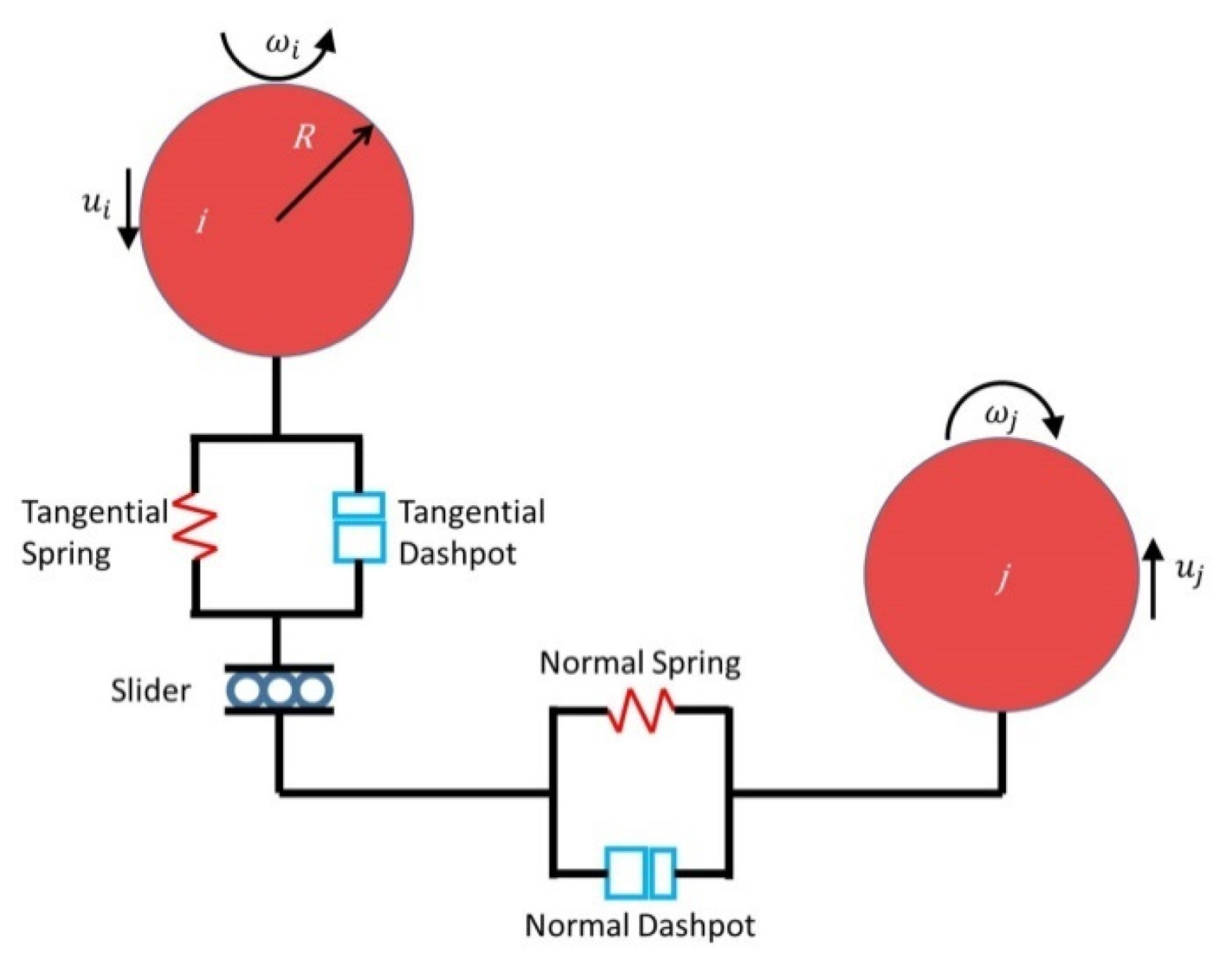

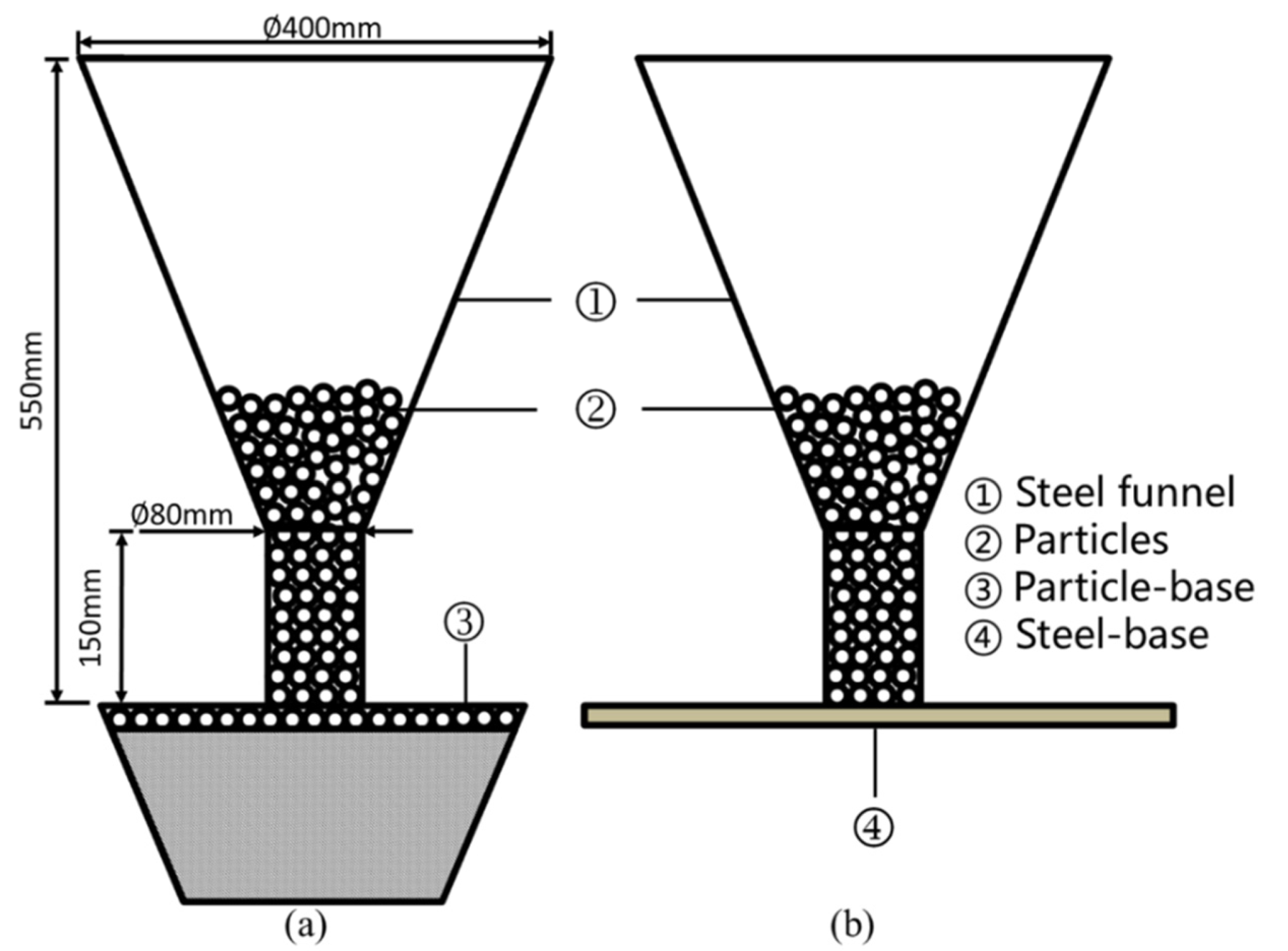
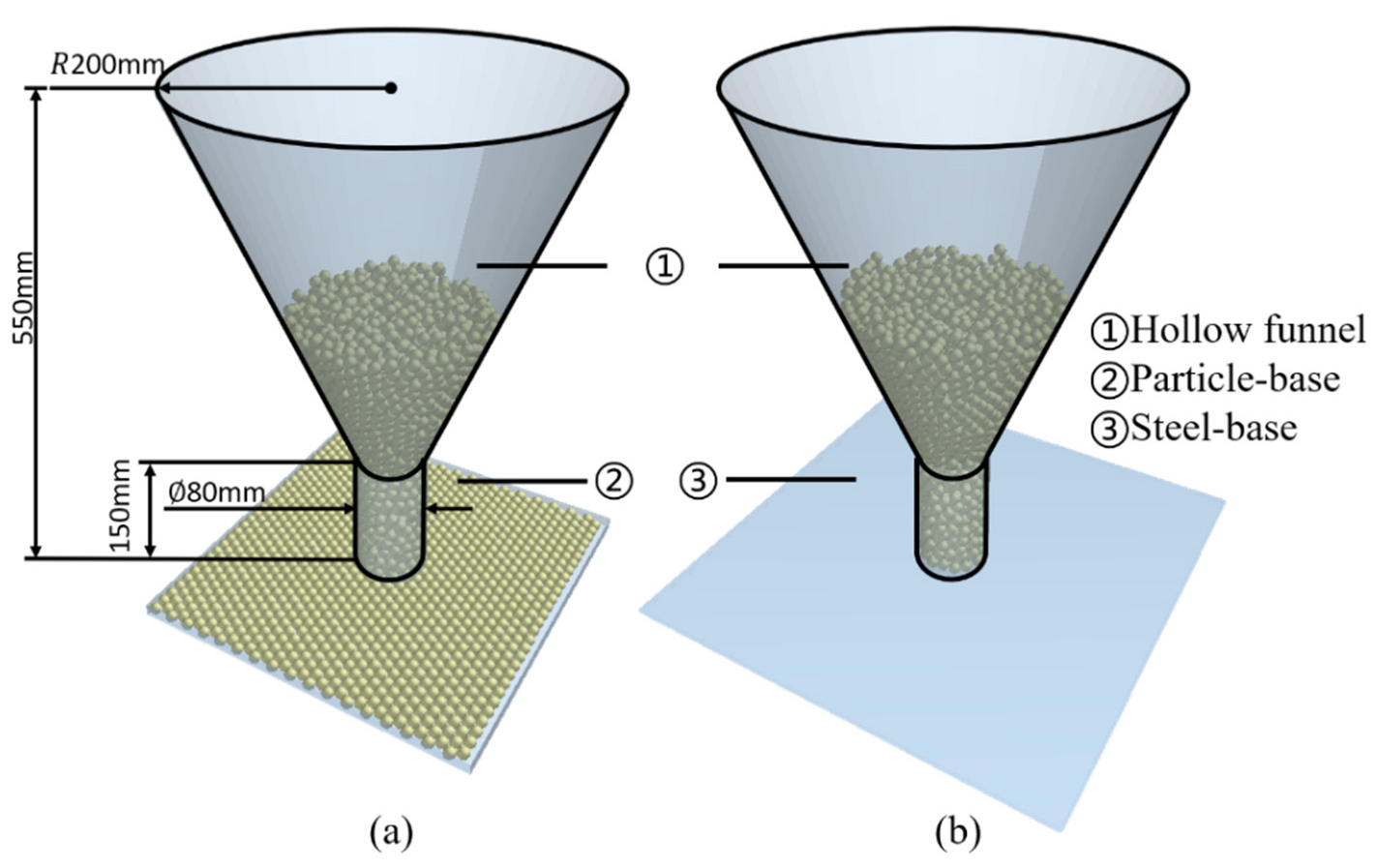
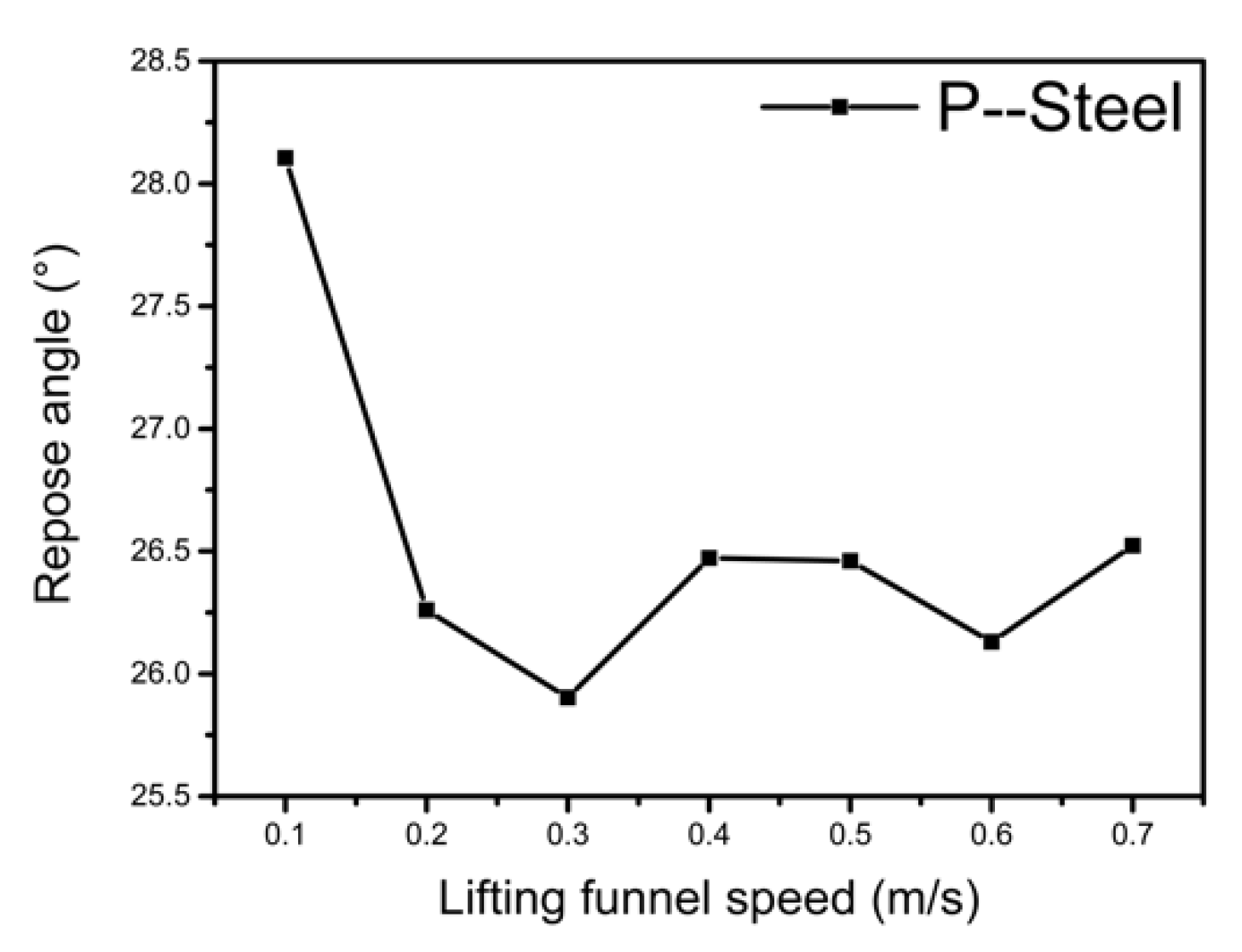

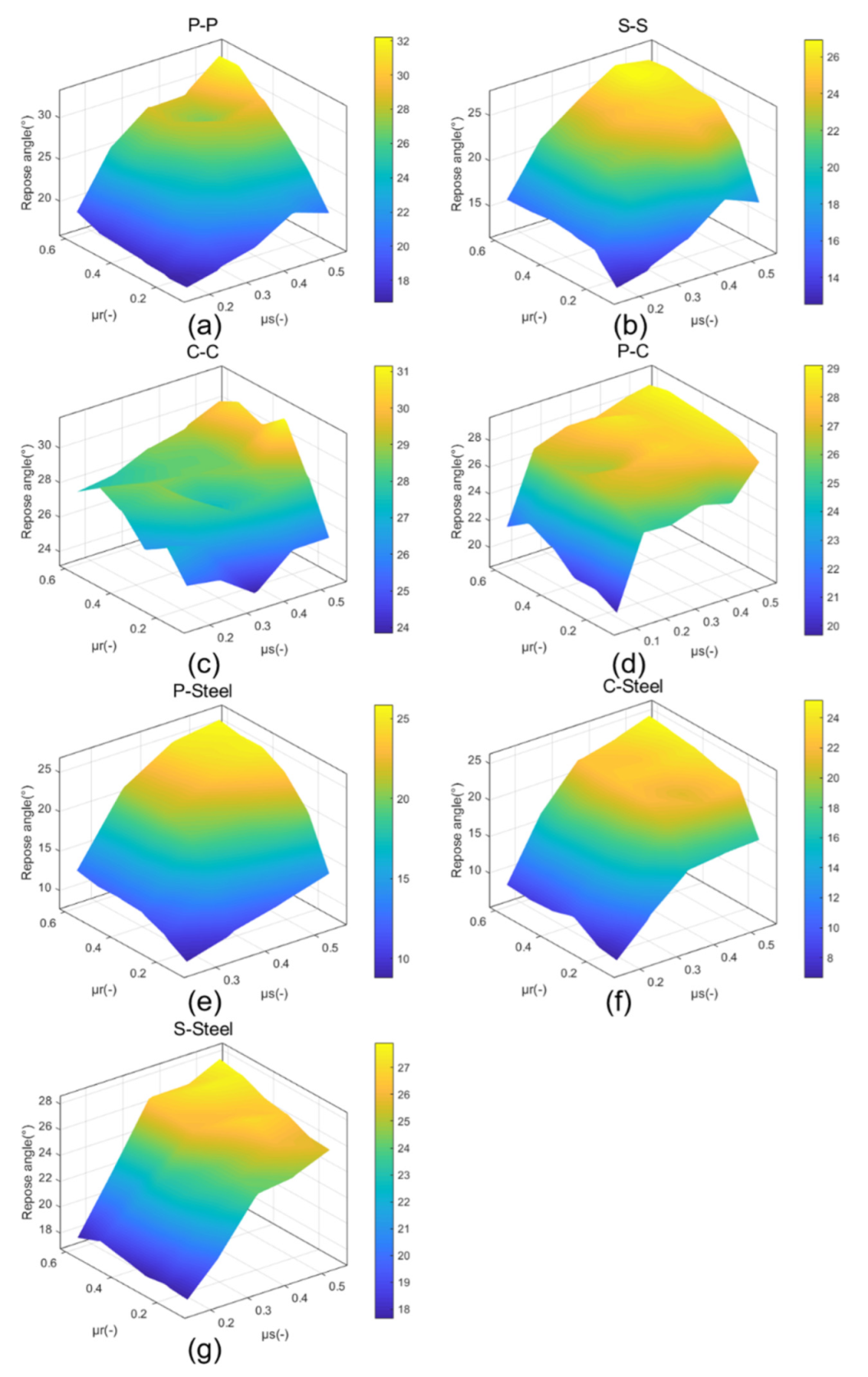

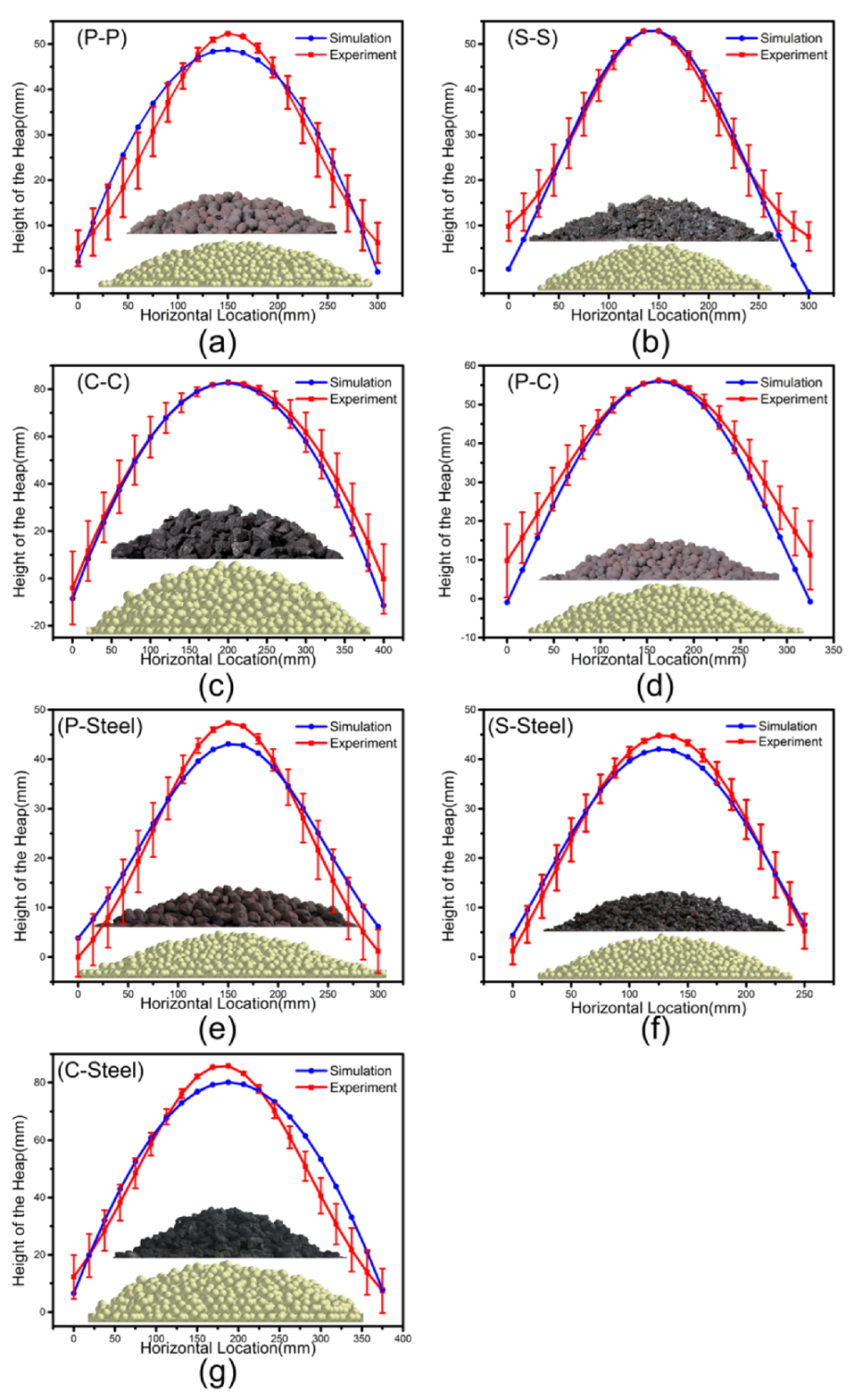
| Materials | Pellet | Sinter | Coke |
|---|---|---|---|
| Mass (kg) | 4 | 2 | 2 |
| Size (diameter/ESD, mm) | 8–13 | 6–8 | 13–15 |
| Particle number (-) | 2000 | 2500–3500 | 1500–2000 |
| Materials | P | S | C | Steel |
|---|---|---|---|---|
| Diameter (mm) | 10 | 8 | 13 | |
| Density (kg/m3) | 2284 | 3300 | 1050 | 7800 |
| Young’s modulus (Pa) | 2.5 × 107 | 3.5 × 109 | 5.37 × 108 | 2 × 1011 |
| Poisson’s ratio (-) | 0.25 | 0.25 | 0.22 | 0.30 |
| Coefficient of restitution (-) | 0.60 | 0.18 | 0.20 |
| Groups | P-P | S-S | C-C | P-Steel | S-Steel | C-Steel | P-C |
|---|---|---|---|---|---|---|---|
| Coefficient of restitution (-) | 0.42 | 0.35 | 0.39 | 0.62 | 0.40 | 0.42 | 0.40 |
| COSF (-) | 0.65 | 0.76 | 0.87 | 0.36 | 0.52 | 0.50 | |
| CORF (-) | 0.24 | 0.38 | 0.46 | 0.16 | 0.25 | 0.31 |
| Groups | P-P | S-S | C-C | P-C | P-Steel | S-Steel | C-Steel |
|---|---|---|---|---|---|---|---|
| Repose angle (°) | 24.73 | 24.96 | 27.40 | 24.91 | 17.68 | 23.72 | 27.22 |
| Relative standard deviation (-) | 0.086 | 0.095 | 0.049 | 0.044 | 0.075 | 0.063 | 0.086 |
| Groups | Physical/° | Simulation/° (μs, μr) | Relative Difference/° |
|---|---|---|---|
| P-P | 24.73 | 25.06 (0.55, 0.20) | 0.33 |
| S-S | 24.96 | 25.53 (0.50, 0.30) | 0.57 |
| C-C | 27.40 | 28.89 (0.45, 0.30) | 1.49 |
| P-C | 24.91 | 25.60 (0.25, 0.10) | 0.69 |
| P-Steel | 17.68 | 17.87 (0.45, 0.20) | 0.19 |
| S-Steel | 23.72 | 23.71 (0.50, 0.20) | 0.01 |
| C-Steel | 27.22 | 27.32 (0.42, 0.25) | 0.10 |
Publisher’s Note: MDPI stays neutral with regard to jurisdictional claims in published maps and institutional affiliations. |
© 2022 by the authors. Licensee MDPI, Basel, Switzerland. This article is an open access article distributed under the terms and conditions of the Creative Commons Attribution (CC BY) license (https://creativecommons.org/licenses/by/4.0/).
Share and Cite
Wei, S.; Wei, H.; Saxen, H.; Yu, Y. Numerical Analysis of the Relationship between Friction Coefficient and Repose Angle of Blast Furnace Raw Materials by Discrete Element Method. Materials 2022, 15, 903. https://doi.org/10.3390/ma15030903
Wei S, Wei H, Saxen H, Yu Y. Numerical Analysis of the Relationship between Friction Coefficient and Repose Angle of Blast Furnace Raw Materials by Discrete Element Method. Materials. 2022; 15(3):903. https://doi.org/10.3390/ma15030903
Chicago/Turabian StyleWei, Shiyu, Han Wei, Henrik Saxen, and Yaowei Yu. 2022. "Numerical Analysis of the Relationship between Friction Coefficient and Repose Angle of Blast Furnace Raw Materials by Discrete Element Method" Materials 15, no. 3: 903. https://doi.org/10.3390/ma15030903
APA StyleWei, S., Wei, H., Saxen, H., & Yu, Y. (2022). Numerical Analysis of the Relationship between Friction Coefficient and Repose Angle of Blast Furnace Raw Materials by Discrete Element Method. Materials, 15(3), 903. https://doi.org/10.3390/ma15030903








